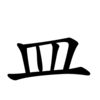皿
| ||||||||
Translingual
| Stroke order | |||
|---|---|---|---|
 | |||
Han character
皿 (radical 108, 皿+0, 5 strokes, cangjie input 月廿 (BT), four-corner 77100, composition ⿴𠀃⿰丨丨)
- Kangxi radical #108, ⽫.
Derived characters
- Index:Chinese radical/皿
References
- KangXi: page 792, character 33
- Dai Kanwa Jiten: character 22941
- Dae Jaweon: page 1207, character 29
- Hanyu Da Zidian: volume 4, page 2557, character 1
- Unihan data for U+76BF
Chinese
| simp. and trad. |
皿 | |
|---|---|---|
Glyph origin
| Historical forms of the character 皿 | |||
|---|---|---|---|
| Shang | Western Zhou | Shuowen Jiezi (compiled in Han) | Liushutong (compiled in Ming) |
| Oracle bone script | Bronze inscriptions | Small seal script | Transcribed ancient scripts |
 |
 |
 |
 |
| Characters in the same phonetic series (皿) (Zhengzhang, 2003) | |
|---|---|
| Old Chinese | |
| 猛 | *mraːŋʔ |
| 艋 | *mraːŋʔ |
| 蜢 | *mraːŋʔ |
| 皿 | *maŋʔ |
| 孟 | *mraːŋs |
Pictogram (象形) A pictograph of an empty container, such as a chalice. The handles are conjoined in the modern form.
Etymology 1
Pronunciation
Usage notes
- As a component of other characters, 皿 can be referred to as 皿字底 (mǐnzìdǐ) or 皿墩兒/皿墩儿 (mǐndūnr).
Japanese
Korean
Hanja
皿 • (myeong) (hangeul 명, revised myeong, McCune–Reischauer myŏng, Yale myeng)
- This term needs a translation to English. Please help out and add a translation, then remove the text
{{rfdef}}.
Vietnamese
This article is issued from
Wiktionary.
The text is licensed under Creative
Commons - Attribution - Sharealike.
Additional terms may apply for the media files.